
Compression hosiery are continuously evolving and being released with new designs. Zippered stockings have become a relatively older design but are still greatly sought out for. In addition to the benefits provided by regular compression hosiery, they offer convenience by easily being zipped up for wear.
What is the difference between zippered and non-zippered compressed stockings?

Zippered compression stockings brandish a durable zipper. Like their non-zippered counterparts, these are typically made of the same material, such as as nylon, spandex, cotton, or wool. The added zippers allows a smoother and more efficient wearing process.
Are there any differences in comfort or feel between a pair of zippered compression stockings and a pair of non-zippered ones? Not necessarily.
Manufacturers tend to standardize their stockings to ensure that both kinds have the similar lengths, configurations (e.g. open-toe, closed-toe, etc.), sizes, and designs.
How do they work?
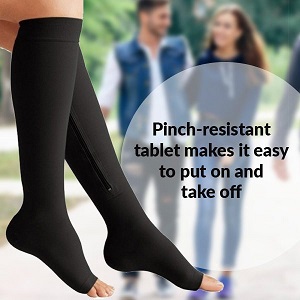
Compression hosiery work by applying pressure on the wearer’s legs. The elastic material in the fabric creates a tension that squeezes the legs gently when you put it on.
Perhaps a question that may arise is: what is the purpose of placing pressure on the legs?
The answer lies in the fact that swelling, edema, and soreness of the legs is associated with poor circulation and accumulation of fluid in the blood vessels of the feet and ankles. The pressure applied by compression stockings pushes the stagnant blood out and allows fresh blood to take its place.
What are the benefits of wearing them?
Compression garments are not only a remedy for feet swelling, but doctors and medical professionals also prescribe them for several health issues in the legs.
Some of the benefits of wearing compression stockings include:
1. Improves Blood Circulation
By adding pressure on the wearer’s lower extremities, blood is prevented from pooling in a single area. This reduces the risk of edema, swelling, and other circulatory issues.
2. Controls Lymphedema and Other Health Issues
Lymphedema is a type of edema in which the cause of swelling in the legs or feet is lymph fluid, in which lymph fluid may leak from the network of lymph vessels (and capillaries) and, thus, causing swelling.
A moderate level of compression, which is a range of about 20 to 30 mmHg (i.e. mmHg is a unit of measurement for pressure, read as ‘millimeters of mercury’), would be effective in reducing the risk of lymphedema from occurring.
Some circulatory issues may need a higher compression level up to 40 mmHg, such as varicose veins, spider veins, deep vein thrombosis (DVT), blood clotting, leg ulcers, and other venous insufficiency symptoms.
3. Improves Athletic Performance
Compression stockings and compression sleeves can improve athletic performance during training and workout sessions. Compression garments provide support, flexibility, and strength to the muscles to optimize the performance of sports players, fitness enthusiasts, and professional competitors.
4. Quickens Recovery from Muscle Fatigue Strain

The speed of recovery can be critical for athletes. Muscle fatigue after strenuous activity is a natural response from the body and can be handled by the use of compression stockings.
5. Assists in Post-Surgery Recovery
Patients recovering from surgery can utilize compression socks as they rest and recover. For leg ulcers, varicose veins, and surgical treatment of venous disorders, compression stockings act as a type of wound care. Even if the surgery performed is not directly related to the legs, post-surgical rehabilitation clinics recommend compression hosiery to improve blood circulation in the legs, feet, and ankles as a patient may become bedridden for a while.
6. Prevents Swelling During Traveling
Long road trips and flights that last hours can leave legs feeling cold, achy or tired. Continuous traveling and standing or sitting long hours with little to no rest can cause edema and may even cause swelling in the limbs. Compression stockings can alleviate such soreness and swelling in the feet.
Who can wear them?
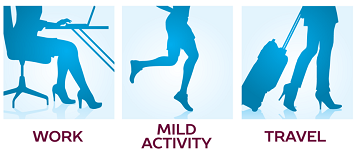
Men and women of all ages can wear zippered compression socks.
The zippered design can be useful for most individuals, particularly the following:
1. Individuals with Chronic Swelling and Edema
In some extreme cases of chronic edema and chronic venous disease, regular and strict use of compression garments (with periodic consultation with their doctor) may be required. As a result, compression hosiery will need to be worn frequently, which can be a tedious routine of taking them off and putting them on again. Zippered compression stockings come in handy for saving time, bring major convenience to the wearer.
2. Bedridden Patients and Individuals
Fractures, other injuries, and surgeries may cause an individual to be bedridden for a period of time. They typically are also not allowed to move too much to ensure proper healing. This can bring difficulty putting on regular socks, usually requiring assistance from a nurse, friend, or family member. Zippered compression stockings can bring ease on putting on hosiery on the bedridden individual, as well as ensuring proper blood circulation as they remain sedentary.
3. Pregnant Women, Overweight Individuals, and Elders
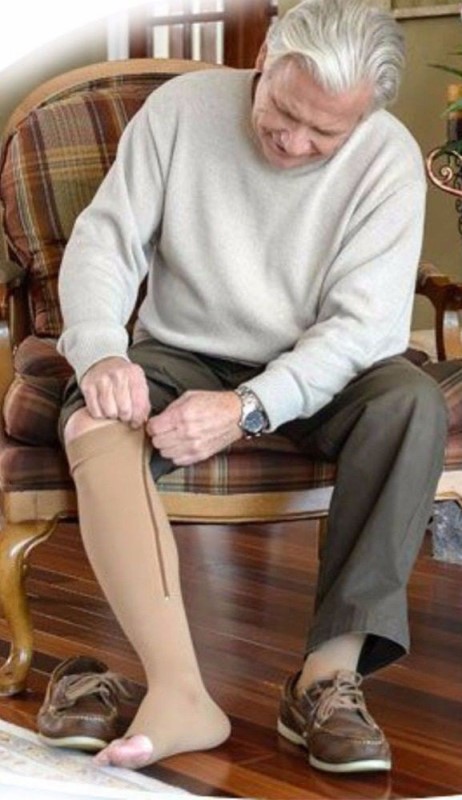
Pregnant women may find it difficult to stretch and bend over to put on socks; zippered compression stockings allows them to put socks on with minimum effort. The compression also helps reduce swelling in the feet.
Obesity can limit movement and cause swollen feet and ankles. Zippered compression socks can help and enable obese individuals to put on socks easily.
Elders and seniors face similar issues; they may even face arthritis, edema, or other problems that can restrict their movement and flexibility. Many elders living in senior citizen homes need constant care, and that includes assistance in wearing their clothes, shoes, and compression hosiery. Compression stockings with zippered design can make it convenient for the nurses and helpers to look after their needs. It can reduce their workload as well as allow elders to wear compression stockings.
Why should I choose zippered compression stockings over non-zippered ones?
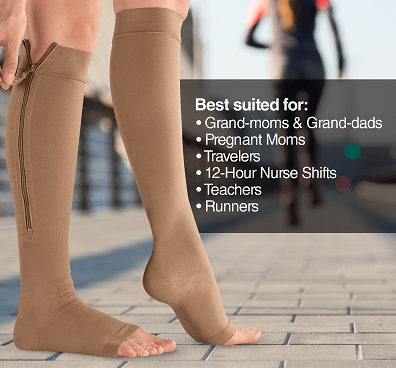
Zippered compression stockings can have several advantages over non-zippered ones, such as:
1. Efficiency
Although non-zippered compression stockings do not take a lot of time to put on and take off, zippered compression stockings can take even lesser time to do so. If you are in a rush or have a busy schedule, these can help you get ready in no time.
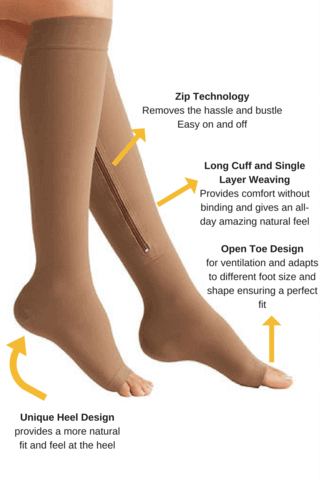
2. Ultra Easy to Wear
With zippers, the wearing process is as simple as follows:
1. Gently slide your foot into an unzipped stocking, toe-first, until the foot and calf is entirely inside.
2. With one hand, close the sleeves of the stocking and, with the other hand, pull the zip upward.
3. Afterwards, check to ensure there are no folds on the stocking.
3. Less Chances of Damaging the Fabric

Zippered compression socks are less likely to get damaged because of not needing to force your foot inside the stocking. The zipper prolongs the life of compression socks by reducing the possibility of damage to the garment.
Are there any drawbacks to choosing zippered compression stockings over non-zippered ones?
The position, stitching, and placement of the zipper is crucial for the integrity of the stocking.

One of the most common risks associated with zippered compression stockings is that it can press against the skin and cause discomfort.
For instance, low-quality zippered compression stockings can leave indentations on the skin, causing itchiness or irritation, or accidentally pinch the skin.
High-quality zippered compression stockings have a special protection flap made of soft fabric or plastic material which protects the user’s skin from the zipper itself.
Another risk is that once the zipper is damaged, the whole stocking may no longer be able to be used. Extra care is necessary to prevent this from happening.
How can I avoid the risks of wearing zippered compression stockings?
Simply buy good quality zippered compression stockings from manufacturers or retailers with positive reviews and ratings. User reviews can be helpful in determining which brand to purchase from.
Conclusion
A pair of zippered compression stockings provide the same benefits as a pair of non-zippered compression stockings but also allow a more efficient way of putting them on and taking them off, which would be especially useful to individuals who may not be able to do so as easily.
